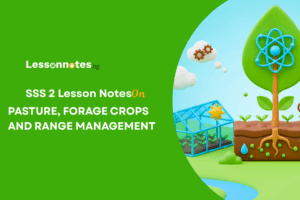Forest Management SS2 Agricultural Science Lesson Note
Download Lesson NoteTopic: Forest Management

FOREST
A forest can be defined as a large area of land covered with trees and bushes, either growing wild or planted for some purposes which serves as a habitat for various kinds of animals.
NOTE:
- Forestry is the management of forest and forest resources.
- Silviculture is the growing and cultivation of trees.
- Forest ecology is the scientific study of interrelated organisms in the forest.
COMMON FOREST TREES
Common forest trees found in the forest are Iroko, Obeche, Mahogany, Nigerian walnut, Ebony, Camwood, Opepe, Afara, Teak and Abura.
FOREST RESERVES IN NIGERIA
Forest reserves are large areas of land where plants, either growing naturally or planted, are specially preserved for specific purposes.
SOME FOREST RESERVES IN NIGERIA
- Mamu River Forest Reserve in Anambra State.
- Omo Forest Reserve in Ogun State.
- Afi River Forest Reserve in Cross Rivers State.
- Okomu Forest Reserve in Edo State.
- Shasha River Forest Reserve in Ogun State.
- Zamfara Forest Reserve in Zamfara state.
- Sanga River Forest Reserve in Plateau State.
IMPORTANCE OF FOREST AND ITS RESOURCES
The following are ways in which the forest and its resources are important to us. They are as follows:
- Provision of food.
- Provision of fuel.
- Provision of medicinal herbs.
- Provision of employment (lumbering).
- The forest serves as a windbreak.
- Formation of rain.
- Prevention of soil erosion.
- Addition of nutrients to soil.
- Home of wild animals.
- The forest serves as a tourist centre.
- Provision of foreign exchange.
- It beautifies the environment and serves as a tourist sites.
- Reduction of atmosphere pollution.
- Sources of raw materials such as pulp, timber, dye, gum latex etc.
MANAGEMENT OF THE FOREST
The following are management practices that will ensure a constant supply of timber in the forest:
- Forest Regulation: These are laws promulgated by the government in the form of edicts, decrees and bye-laws to prevent people from exploiting or indiscriminately tapping forest resources. They include:
i. The prohibition of bush burning
ii. Ban on indiscriminate cutting of timber trees
iii. Encouraging people to plant trees
iv. Ban or collection of leaves and firewood from the forest
v. Ban or farming in forest reserves
vi. Ban or cut down of under aged trees
vii. People are to obtain licenses to secure permission to enable them to cut down trees for human needs.
- Selective Exploration
This is the process of cutting or harvesting only mature trees in the forest.
Advantages Of Selective Exploration
i. It ensures the concentration of selected species of timber in the forest
ii. It protects soil from erosion
iii. It ensures a continuous supply of timber
iv. It serves as a revenue base for the government
v. It prevents indiscriminate felling of timber
- Deforestation
This is the continuous or indiscriminate removal of trees without replacing them.
Causes Of Deforestation
i. Unfavorable climatic factors such as draught, wind blast etc
ii. Man farming activities such as bush burning, shifting cultivation etc.
iii. Timber exploitation
iv. Mining/industrialization
v. Natural disasters
vi. Bad government policies
Effects Of Deforestation
i. It encourages soil erosion.
ii. It leads to a reduction in the fertility of the soil.
iii. It reduces the amount of rainfall in an area.
iv. It reduces soil moisture content.
v. It increases the leaching of plant nutrients.
vi. It destroys the microclimate and warms up the environment.
vii. It may lead to desert encroachment
- Regeneration
Regeneration is the process of forest regrowth after it has been exploited. It is a deliberate effort to grow trees.
Types Of Regeneration
- Natural Regeneration: in this type, there is a re-growth of new plants from the old stump.
- Artificial Regeneration: this involves the planting of new forest seedlings in a deforested area.
Advantages Of Natural Regeneration
i. It is less expensive when compared with artificial regeneration.
ii. It does not require formal stages in plantation establishment.
iii. It brings about the stabilization of the natural ecosystem.
iv. It does not require special management skills.
- Deforestation
This is the process of establishing forest plantations in any area.
Advantages Of Deforestation
i. It leads to the addition of organic matter.
ii. It provides a regular supply of raw materials e.g. timber for industries.
iii. It prevents desert encroachment.
iv. It increases forest fauna (wildlife) in the area concerned.
v. It prevents the leaching of plant nutrients.
vi.It increases soil moisture retention.
vii. It increases the amount of rainfall.
viii. It improves the soil structure.
- Taungya System
The Taungya system is defined as the planting of arable crops at an early stage of forest establishment and the arable crops are harvested before the trees form canopies.
Condition Necessary For The Practice Of the Taungya System
The conditions which may favour the practice of the tangy system include:
i. Scarcity of land
ii. Overpopulation
iii. Unemployment
iv. Government policies
v. Low standard of living
Advantages Of Taungya Farming
i. Varieties of crops are harvested
ii. There is availability of crop produce throughout the year
iii. When leguminous crops are used they fix nitrogen to the soil
iv. Solves the problem of land scarcity
v. It increases the income of the farmer
Disadvantages Of Taungya Farming
i. Reluctance in releasing fertile soil
ii. Cultivation of selected crops
iii. Competition between crops and trees
iv. Inability of some crops to survive
ASSIGNMENT
- The indiscriminate removal of trees is called____. A. deforestation B. deforestation C. tangy farming D. wedding
- The following are forest trees except ____. A. iroko B. obeche C. hibiscus D. ebony
- The process of establishing a forest plantation is called ____. A. afforestation B. deforestation C. tangy D. wedding
- The process of cutting only matured trees in a forest is called ______. A. selective exploitation B. selective exploration C. tangy D. aforestation
- The best soil for Agriculture is _____. A. Loamy soil B. sandy soil C. clay soil D. silt soil






















